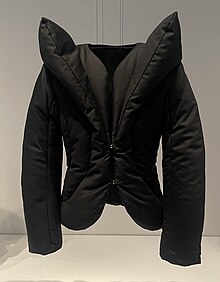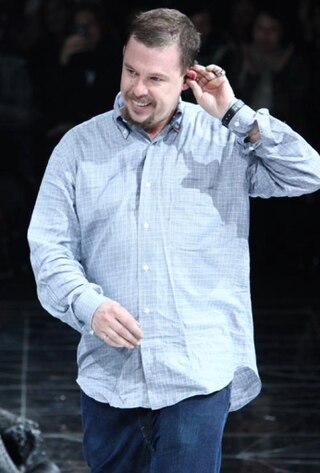
Lee Alexander McQueen was a British fashion designer and couturier. He founded his own Alexander McQueen label in 1992, and was chief designer at Givenchy from 1996 to 2001. His achievements in fashion earned him four British Designer of the Year awards, as well as the Council of Fashion Designers of America International Designer of the Year award in 2003. McQueen died by suicide in 2010 at the age of 40, at his home in Mayfair, London, shortly after the death of his mother.

Metal corsets are a type of historical corset or bodice made entirely out of metal, usually iron or steel. The metal corset was popularly claimed to have been introduced to France by Catherine de' Medici in the 16th century, although this is now considered a myth. The idea that such garments were worn for fashionable purposes is debatable, with fashion historians now regarding such claims sceptically. Many of the original metal bodices that have survived are now believed to have been intended for medical purposes as orthopaedic support garments and back braces. Such garments were described by the French army surgeon Ambroise Paré in the 16th century as a remedy for the "crookednesse of the Bodie."

Alexander McQueen is a British luxury fashion house founded by the designer Alexander McQueen in 1992. After his death, Sarah Burton was its creative director, from 2010 to 2023. Gianfilippo Testa has been CEO since March 2022 and Seán McGirr has been creative director since October 2023. The house specializes in haute couture, ready-to-wear, premium leather accessories, as well as footwear.

Shaun Leane is a British jewellery designer best known for his sculptural pieces created for Alexander McQueen. His eponymous jewellery brand is a four-time winner of the UK Jewellery Designer of the Year award.

Dante is the eighth collection launched by the British fashion designer Alexander McQueen. The concept for this collection was mainly inspired by the 14th century Florentine poet, writer and philosopher Dante Alighieri and his famous work Divine Comedy. The show was set in the Christ Church in Spitalfields on 1 March 1996. Some of the garments featured prints of Don McCullin’s photographs taken during the Vietnam War (1955-1975) and crucifix masks inspired in the photographer and a continuous referent in McQueen’s work, Joel-Peter Witkin’s self-portraits; the looks for this show also included Philip Treacy headpieces. The show was dedicated to McQueen’s long-time friend and muse, Isabella Blow; it constituted a commentary on religion and war.

The Widows of Culloden is the twenty-eighth collection by British fashion designer Alexander McQueen, made for the Autumn/Winter 2006 season of his eponymous fashion house. It was inspired by his Scottish ancestry and is regarded as one of his most autobiographical collections. It is named for the women widowed by the Battle of Culloden (1746), often seen as a major conflict between Scotland and England. Widows makes extensive use of the McQueen family tartan and traditional gamekeeper's tweeds, as well as other elements taken from Highland dress. Historical elements reflected the fashion of the late Victorian era and the 1950s.
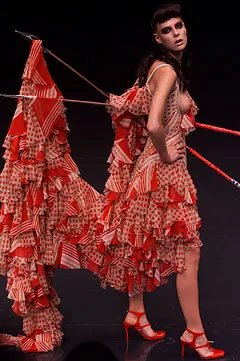
The Dance of the Twisted Bull is the nineteenth collection by British designer Alexander McQueen for his eponymous fashion house. Twisted Bull was inspired by Spanish culture and art, especially the traditional clothing worn for flamenco dancing and bullfighting. In McQueen's typical fashion, the collection included sharp tailoring and historicist elements and emphasised femininity and sexuality.

The Birds is the fifth collection by British designer Alexander McQueen for his eponymous fashion house. The Birds was inspired by ornithology, the study of birds, and the 1963 Alfred Hitchcock film The Birds, after which it was named. Typically for McQueen in the early stages of his career, the collection centred on sharply tailored garments and emphasised female sexuality. McQueen had no financial backing, so the collection was created on a minimal budget.

Neptune is the twenty-seventh collection by British designer Alexander McQueen for his eponymous fashion house. It took inspiration from classical Greek clothing, 1980s fashion, and the work of artists influential in that decade. The runway show was staged during Paris Fashion Week on 7 October 2005 at the industrial warehouse of the Imprimerie Nationale. Two main phases were presented, with 56 looks total: the first phase comprised monochrome black clothing, while the second featured a white, green, and gold palette. The collection's clothing and runway show both lacked McQueen's signature theatricality, and critical reception at launch and in retrospect was negative. Items from Neptune appeared in the 2022 exhibition Lee Alexander McQueen: Mind, Mythos, Muse.

Irere was the twenty-first collection by British fashion designer Alexander McQueen for his eponymous fashion house. Irere was inspired by imagery from the Age of Discovery and from the people and animals of the Amazon rainforest. Its title is claimed to mean 'transformation' in an unspecified Indigenous Amazonian language. The collection comprised three distinct concepts presented as a narrative sequence: shipwrecked pirates, menacing conquistadors, and tropical birds. McQueen described the collection as an effort to present a more mature point of view and surprise viewers with bold colours.

The oyster dress is a high fashion gown created by British fashion designer Alexander McQueen for his Spring/Summer 2003 collection Irere. McQueen's design is a one-shouldered dress in bias-cut beige silk chiffon with a boned upper body and a full-length skirt consisting of hundreds of individual circles of organza sewn in dense layers to the base fabric, resembling the outside of an oyster shell. According to McQueen, the gown took a month's work for three people, who cut and assembled all the pieces individually. In addition to the original beige dress, a version with a red bodice and the ruffled skirt in rainbow colours was also created. The beige and red versions appeared in the Irere runway show, and were photographed for magazines to promote the collection.
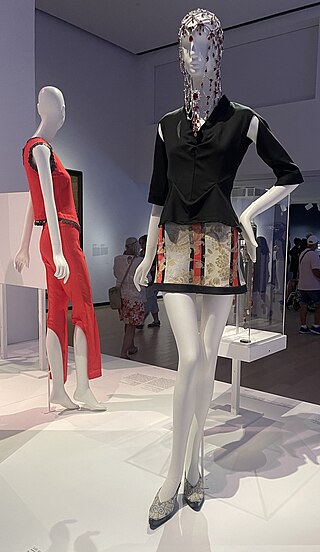
Eye was the fifteenth collection by British fashion designer Alexander McQueen for his eponymous fashion house. It was inspired by the culture of the Middle East, particularly Islamic clothing, as well as the oppression of women in Islamic culture and their resistance to it. The collection crossed traditional Middle Eastern garments with elements drawn from Western fashion such as sportswear and fetishwear. Jeweller and frequent McQueen collaborator Shaun Leane provided the collection's best-known design: a yashmak made from chainmail.
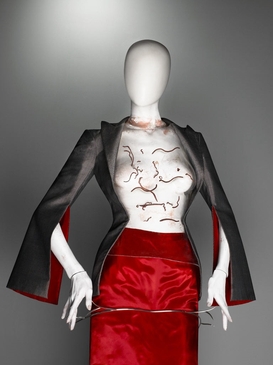
The Hunger is the seventh collection by British designer Alexander McQueen for his eponymous fashion house. The collection was primarily inspired by The Hunger, a 1983 erotic horror film about vampires. McQueen had limited financial backing, so the collection was created on a minimal budget. Typically for McQueen in the early stages of his career, the collection centred around sharply tailored garments and emphasised female sexuality. It was his first collection to include menswear.

Pantheon ad Lucem is the twenty-fourth collection by British designer Alexander McQueen for his eponymous fashion house. Inspired by ideas of rebirth, ancient Greek garments and science fiction films including 2001: A Space Odyssey (1968) and Star Wars (1977), the collection focused on sleek draped, wrapped, or tied jersey designs in light and neutral colours, with some evening wear in darker colours. Contrasting the slimline items were heavier garments including tweed suits and fur coats. McQueen expressed his fascination with altering the silhouette, emphasising the hips to a degree that was uncommon for him.

The Girl Who Lived in the Tree is the thirty-second collection by British fashion designer Alexander McQueen, made for the Autumn/Winter 2008 season of his eponymous fashion house. The primary inspirations were British culture and national symbols, particularly the British monarchy, as well as the clothing of India during the British Raj. The collection was presented through the narrative of a fairy tale about a feral girl who lived in a tree before falling in love with a prince and descending to become a princess.

Joan was the twelfth collection by British fashion designer Alexander McQueen for his eponymous fashion house. Continuing McQueen's dual fascination with religion and violence, it was inspired by imagery of persecution, most significantly the 1431 martyrdom of French Catholic saint Joan of Arc, who was burned at the stake. The collection's palette was mainly red, black, and silver; colours which evoked notions of warfare, death, blood, and flames. Many looks referenced ecclesiastical garments and medieval armour, including several items that mimicked chainmail and one ensemble that had actual silver-plated armour pieces.

Voss is the seventeenth collection by British fashion designer Alexander McQueen, made for the Spring/Summer 2001 season of his eponymous fashion house. The collection drew on imagery of madness and the natural world to explore ideas of bodily perfection, interrogating who and what was beautiful. Like many of McQueen's collections, Voss also served as a critique of the fashion industry, which McQueen was often ambivalent about. Voss featured a large number of showpiece designs, including dresses made with razor clam shells, an antique Japanese screen, taxidermy hawks, and microscope slides. The collection's palette mainly comprised muted tones; common design flourishes included Orientalist and surrealist elements.

The Horn of Plenty: Everything But the Kitchen Sink is the thirty-fourth collection by British fashion designer Alexander McQueen, made for the Autumn/Winter 2009 season of his eponymous fashion house. The collection drew on household rubbish and the aesthetics of classic haute couture fashion to satirise the fashion industry for its wastefulness and lack of originality. The Horn of Plenty also featured reimagined designs and reworked items from previous collections, serving as a retrospective of McQueen's own design history. Common design flourishes included houndstooth patterns, design elements overdone to ironic proportions, and prints based on the natural world. Production was shadowed by photographer Nick Waplington, who published a photo book documenting the collection's creation in 2013.

What a Merry-Go-Round is the eighteenth collection by British fashion designer Alexander McQueen, made for the Autumn/Winter 2001 season of his eponymous fashion house. The collection drew on imagery of clowns and carnivals, inspired by McQueen's feelings about childhood and his experiences in the fashion industry. The designs were influenced by military chic, cinema such as Nosferatu (1922) and Cabaret (1972), 1920s flapper fashion, and the French Revolution. The palette comprised dark colours complemented with neutrals and muted greens. The show marked the first appearance of the skull motif that became a signature of the brand.

The Man Who Knew Too Much is the twenty-sixth collection by British designer Alexander McQueen for his eponymous fashion house. It took inspiration from the fashion of the 1950s and 1960s, as well as the films of Alfred Hitchcock; its namesake is Hitchcock's The Man Who Knew Too Much (1956). The runway show was staged during Paris Fashion Week on 4 March 2005 at the Lycée Carnot, a secondary school in Paris. Forty-eight looks were presented; the first thirty-six were daywear, while the final twelve were eveningwear. The collection's clothing and runway show both lacked McQueen's signature theatricality, and critical reception at launch and in retrospect was negative. It was the debut of the Novak handbag, which was a best-seller for the brand. Critical analysis has examined why McQueen pivoted to a more commercial approach, as well as the influence of film on the collection.

